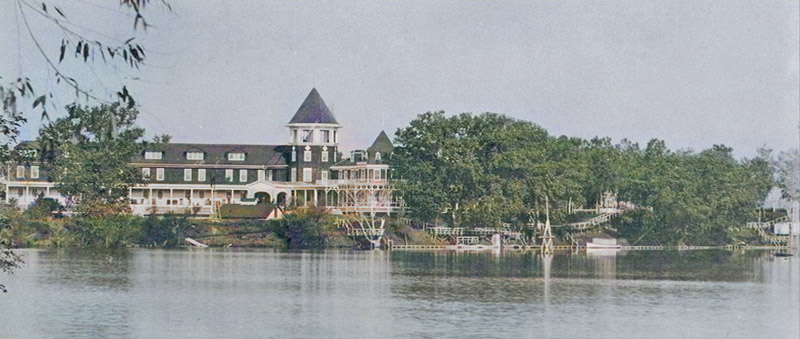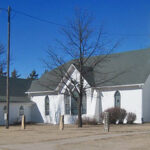
The old Eureka Lake Resort, Near Manhattan, Kansas, was built in 1899 on an elbow of the Kansas River. The flood of 1903 destroyed the lake and resort, and in 1906, the property and hotel were sold to the Odd Fellows and Rebekahs. The hotel was converted into the Rebekah Odd Fellows Home of Kansas and used to house the elderly. On November 26, 1916, the building was destroyed by fire.
More Extinct Towns:
|
Town |
Post Office Dates | Additional Information |
| Alert | 1871-1886 |
The Alert school was formed in 1870. The first church was built in 1874.Unfortunately a fire destroyed the original church A new building was constructed in 1948. It still serves a congregation today. The school closed in 1952. Alert was west of Randolph. |
| Army City | 1918-1922 | Army City was a town built in 1917 to satisfy the needs of Camp Funston on the Fort Riley, Kansas, military reservation. |
| Ashland Colony | None | |
| Bala | 1871-1966 | Bala, Kansas, is a ghost town in eastern Riley County. |
| Berlin | 1872-1876 | |
| Bodaville | 1895-1905 | A rural hamlet near the northern line of Riley County, William Boda was a farmer in the area in 1885. After its post office closed, it received its mail from Barnes, in Washington County. Lasita, on the Rock Island Railroad, ten miles south, was the nearest railway station. The population in 1910 was 50. The last building standing was torn down in 1967. It was about 35 miles from Manhattan, the county seat, and about 12 miles from Barnes. |
| Center Hill | 1903-1904 | |
| Clarkson | 1889-1892 | |
| Cleburne-Big Timber | 1866-1960 | Cleburne, Kansas, formerly known as Big Timber, was a river town located in Riley County. It was located in Swede Township, in the northwest corner of the county. It was razed when Tuttle Creek Dam was built. |
| Donneganna | 1871 | The post office was only open for three months. |
| Grandview | 1895 | The post office was only open for two months. |
| Grant | 1880-1898 | Grant was located in Wildcat Township. The first settlers were S.D. Houston and Henry Eubank, who made their homes on Wild Cat Creek in 1855. The same year, Henry Condray and his sons, Mincher, William, and John, settled near the mouth of Mill Creek, built dwellings, and started a mill and a blacksmith shop. In 1856 Jonas Kress arrived; in 1857 and 1858, Lemuel Knapp, Samuel Kimble, George Slye, John Warner and his sons John and George, Lorenzo Westover, Jesse White, and Joshua Williams. A post office opened on April 16, 1880, with H.C. Kennedy as postmaster. The first schoolhouse was built in 1859 with V. Ruddrick as the first teacher. The first church was the Methodist Episcopal. Though the town showed promising signs in its early years, its post office closed on December 15, 1898. |
| Henryville | 1857-1870 | |
| Lamoil | 1881-1884 | |
| Lasita | 1892-1935 | Michael Senn, a Swiss immigrant, settled the area in 1880. The town quickly grew when the railroad arrived. In 1910, Lasita was a station on the Union Pacific Railroad in Fancy Creek Township. It had a money order post office, some local trade, and a population of 35. When the railroad closed in 1936, Lasita died. It was 32 miles northwest of Manhattan, the county seat. |
| Magic | 1882-1892 | |
| May Day | 1871-1954 | May Day, Kansas, was a hamlet near the west branch of Fancy Creek in northern Riley County. |
| Monterey | 1890-1899 | |
| Shannon | 1855-1858 | |
| Stockdale | 1872-1943 | Stockdale was located at the junction of Mill Creek and the Big Blue River in Grant Township of Riley County. |
| Tauromee | 1856-1858 | The post office moved from Juniata. |
| Timber Creek | 1870-1871 | The post office moved to Bala when it closed. |
| Vinton | 1870-1888 | There was a post office in Ogden Township, the extreme southwestern corner of Riley County. It was eight miles west of Ogden, the nearest railroad point. |
| Walsburg | 1891-1935 |
A Swedish population began to settle in the Walsburg area in the 1860s. A church was built in 1877. It was a station on the Union Pacific Railroad. In 1910, it had a money order post office, local retail trade, and a population of 50. Lighting struck the church in 1918, and the building was destroyed. However, it was soon rebuilt. The church still serves a congregation today. It is all that is left of the old community. It was located about 18 miles northwest of Manhattan, the county seat. |
| Winkler/Winkler’s Mills | 1874-1960 | This village was located on Fancy Creek, in Fancy Creek Township, in the northwestern part of Riley County. It was named for August Winkler of St. Louis, Missouri, who settled in the vicinity in 1857 and built the county’s first permanent grist mill. More settlers arrived in 1872. In 1878, it had a grist and sawmill operated by the Winkler Brothers, a public school, a general store, a blacksmith, a hotel, and a population of 35. It exported grain and cattle from Waterville, on the Central Branch Union Pacific Railroad, 17 miles away. In 1895, Winkler’s Mills’ name was changed to Winkler. In 1910, it had a money-order post office and a population of 18. It was 35 miles from Manhattan, the county seat, and eight miles from Randolph, the nearest shipping point. Today, this old town is under Tuttle Creek Reservoir. |
| Zeandale | 1857-1868 | The unincorporated community of Zeandale, Kansas, is a ghost town near the Kansas River in southeast Riley County. |
©Kathy Alexander/Legends of Kansas, updated July 2025.
Also See:
Big Dam Foolishness at Tuttle Creek Lake
Sources:
1878 Gazetteer and Business Directory R. L. Polk & Co.
Blackmar, Frank W.; Kansas: A Cyclopedia of State History, Vol I; Standard Publishing Company, Chicago, IL 1912.
Cutler, William G.; History of Kansas; A. T. Andreas, Chicago, IL, 1883.
Kansas Post Office History



